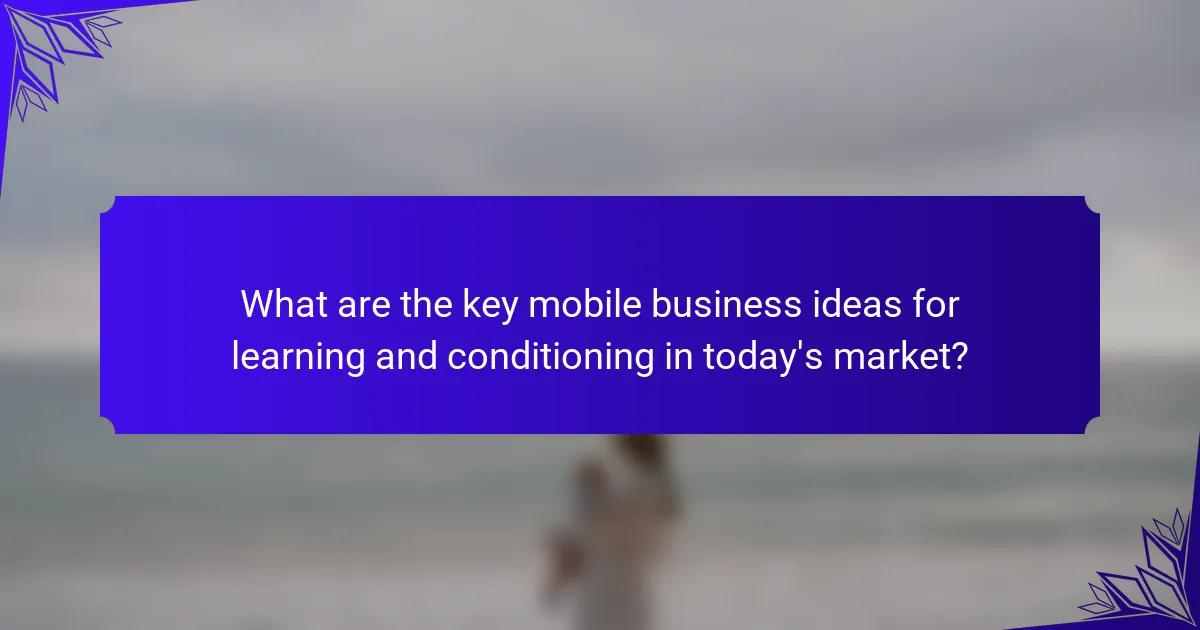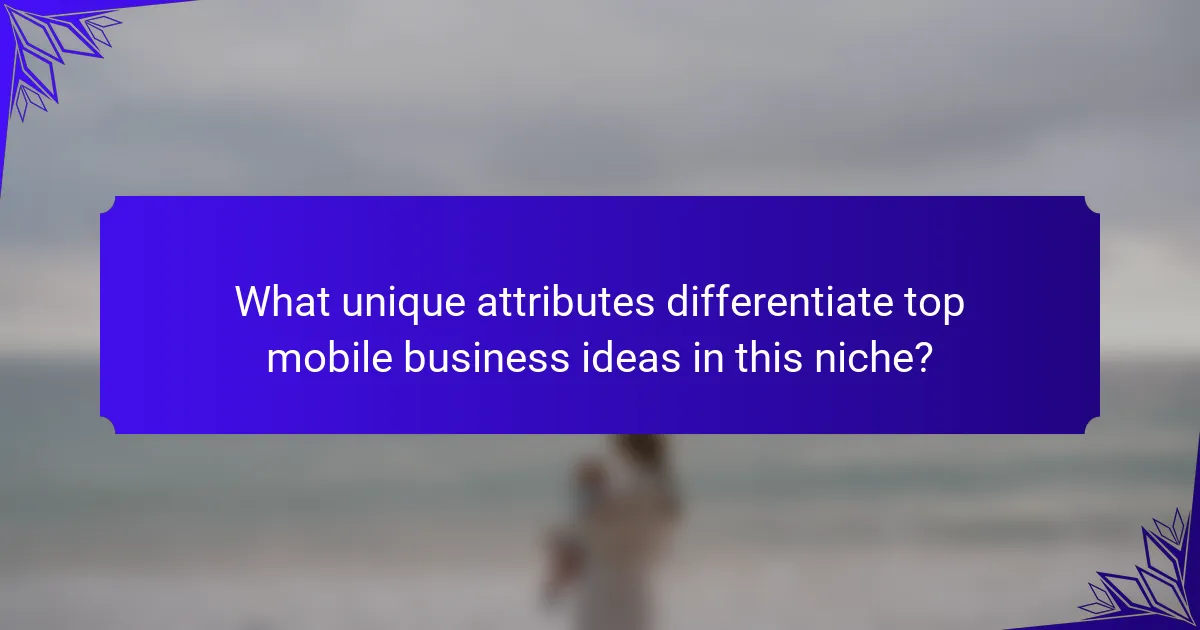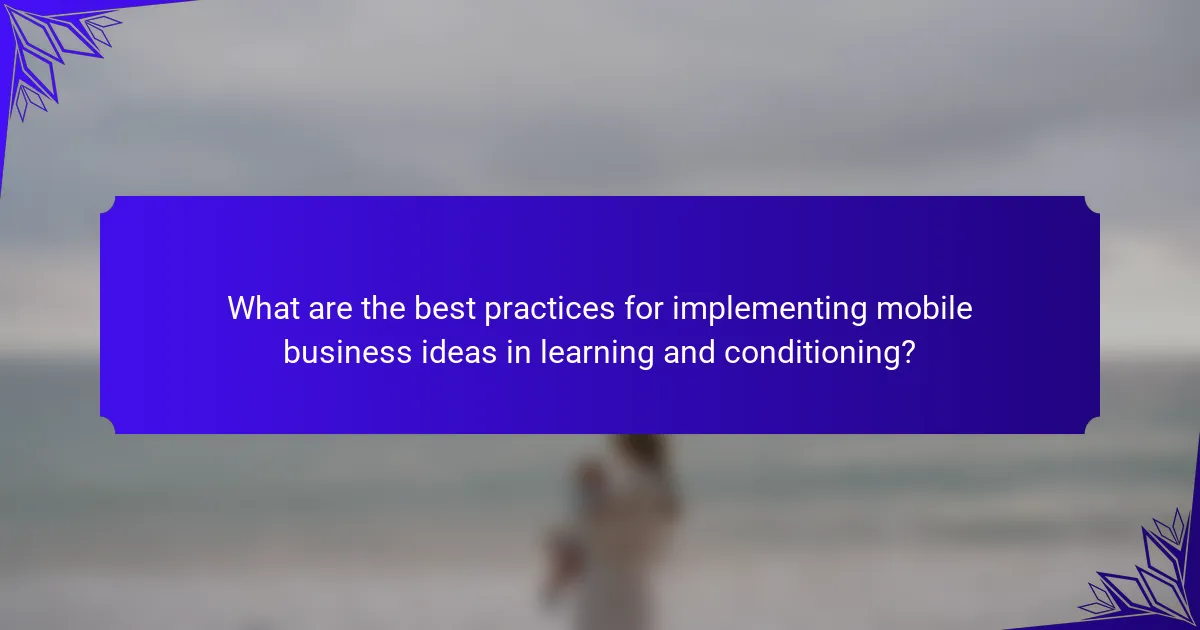Mobile business ideas for learning and conditioning offer innovative strategies to enhance user engagement and accessibility. Key concepts include personalized education apps, fitness tracking platforms, and virtual coaching services. Successful businesses prioritize user-centric design and adaptability while leveraging technology for real-time feedback. Incorporating gamification and analytics can further improve learning outcomes and foster a loyal user base.

What are the key mobile business ideas for learning and conditioning in today’s market?
Mobile business ideas for learning and conditioning include personalized education apps, fitness tracking platforms, virtual coaching services, gamified learning experiences, and online skill development marketplaces. These ideas leverage technology to enhance user engagement and accessibility. Personalized education apps cater to individual learning styles, while fitness tracking platforms provide real-time feedback on health metrics. Virtual coaching services offer tailored guidance, and gamified learning experiences encourage participation through interactive elements. Online skill development marketplaces connect learners with experts, promoting continuous growth.
How do mobile apps enhance learning and conditioning?
Mobile apps significantly enhance learning and conditioning by providing personalized, interactive experiences. They facilitate real-time feedback and adaptive learning pathways tailored to individual needs.
Mobile applications leverage gamification techniques, which increase engagement and motivation through rewards and challenges. This approach fosters a more immersive learning environment, leading to better retention of knowledge.
Additionally, mobile apps offer flexibility in accessing educational content anytime and anywhere, catering to diverse learning styles. This accessibility empowers users to learn at their own pace, ultimately improving their conditioning outcomes.
Data-driven insights from user interactions allow for continuous improvement of app functionalities, ensuring that the learning experience evolves to meet changing demands.
What features make learning apps effective?
Effective learning apps incorporate user engagement, personalized content, and adaptive learning strategies. These features enhance motivation and retention. User engagement is driven by interactive elements and gamification, which make learning enjoyable. Personalized content tailors lessons to individual needs, increasing relevance and effectiveness. Adaptive learning adjusts the difficulty based on user performance, ensuring optimal challenge levels. Together, these attributes create a dynamic learning environment that caters to diverse learning styles and preferences.
Which conditioning techniques are best suited for mobile platforms?
Interactive mobile applications utilizing gamification techniques are best suited for conditioning on mobile platforms. These techniques enhance user engagement through rewards, challenges, and progress tracking. Incorporating personalized feedback and social sharing features further increases motivation. Effective strategies include push notifications to encourage regular interaction and adaptive learning paths tailored to user performance.
What role does gamification play in mobile learning?
Gamification enhances mobile learning by increasing engagement and motivation. It incorporates game-like elements, such as rewards and challenges, which facilitate active participation. This approach improves knowledge retention and encourages consistent learning behaviors. Studies show that gamified learning can boost completion rates by up to 50%. By integrating real-time feedback, learners can track their progress, making the experience more interactive and personalized.
How can game mechanics improve user engagement?
Game mechanics significantly enhance user engagement by fostering interaction, motivation, and a sense of achievement. Incorporating elements like rewards, challenges, and feedback loops keeps users invested in their learning journey. For instance, gamification increases retention rates by 34% in educational apps. Unique attributes such as personalized challenges can cater to individual learning styles, further boosting engagement. As a result, businesses leveraging these mechanics can create more immersive and effective learning experiences.
What are successful examples of gamified learning apps?
Successful examples of gamified learning apps include Duolingo, Kahoot!, and Quizlet. These apps effectively engage users through interactive elements and rewards. Duolingo offers language learning with a point system, motivating users to practice daily. Kahoot! enables quiz-based learning in classrooms, fostering competition and collaboration. Quizlet provides flashcards and games, enhancing retention through varied study modes. Each app demonstrates unique attributes that cater to diverse learning preferences, making them effective tools in today’s educational market.
What unique strategies can businesses adopt for mobile learning?
Businesses can adopt unique strategies for mobile learning by leveraging personalized content delivery, gamification techniques, and real-time feedback mechanisms. Personalized content enhances engagement by tailoring learning experiences to individual needs. Gamification increases motivation through interactive elements like rewards and challenges. Real-time feedback allows learners to track progress, fostering a continuous improvement culture. Additionally, integrating social learning platforms can facilitate collaboration and knowledge sharing among employees. These strategies collectively enhance the effectiveness of mobile learning in today’s market.
How can personalized learning experiences be created?
Personalized learning experiences can be created by leveraging mobile technology to tailor educational content to individual needs. Utilizing data analytics, educators can assess learner preferences and performance, allowing for customized pathways. Interactive mobile applications can facilitate engagement through gamification and adaptive learning techniques. Incorporating feedback mechanisms ensures continuous improvement and relevance of learning materials.
What are the benefits of adaptive learning technologies?
Adaptive learning technologies enhance personalized education by tailoring content to individual needs. They improve engagement, boost retention, and facilitate mastery of concepts through real-time feedback. These technologies adapt learning paths based on performance data, ensuring efficient use of time and resources. As a result, learners achieve better outcomes and experience a more relevant learning journey.

What are the universal attributes of successful mobile learning businesses?
Successful mobile learning businesses share universal attributes that drive their effectiveness. These include user-centric design, adaptability to diverse learning styles, and integration of real-time feedback mechanisms. Additionally, leveraging analytics to personalize learning experiences enhances engagement. Strong partnerships with educational institutions and content creators also contribute to credibility and resource availability.
What are the essential features of effective mobile learning platforms?
Effective mobile learning platforms feature user-friendly interfaces, adaptive learning paths, and robust analytics. These attributes enhance engagement and track progress. Mobile accessibility ensures learning on-the-go, while interactive content fosters active participation. Additionally, integration with other tools supports a seamless learning experience.
How important is user experience in mobile learning applications?
User experience is crucial in mobile learning applications as it directly impacts engagement and retention. A positive user experience fosters motivation, making learners more likely to complete courses. In fact, studies show that 70% of users abandon apps due to poor usability. Effective design elements, such as intuitive navigation and responsive interfaces, enhance accessibility. Furthermore, personalized learning paths cater to unique user needs, improving satisfaction. Prioritizing user experience leads to higher completion rates and better learning outcomes, ultimately driving success in mobile education.

What unique attributes differentiate top mobile business ideas in this niche?
Top mobile business ideas in this niche stand out due to their unique attributes such as scalability, accessibility, and integration of technology. Scalability allows businesses to grow rapidly without significant investment. Accessibility ensures that services reach a broad audience, enhancing user engagement. Integration of technology, like AI or AR, creates innovative user experiences, setting these ideas apart in a competitive market.
How do businesses leverage data analytics for personalized learning?
Businesses leverage data analytics for personalized learning by analyzing user behavior and preferences to tailor educational experiences. This approach enhances engagement and improves learning outcomes. For instance, analytics can identify knowledge gaps, allowing businesses to create targeted content. As a result, companies can optimize training programs and increase employee retention rates. Furthermore, leveraging data analytics enables real-time feedback, which promotes adaptive learning paths that cater to individual needs.
What innovative technologies are shaping mobile learning?
Innovative technologies shaping mobile learning include augmented reality, artificial intelligence, and mobile apps. These tools enhance engagement and personalization, making learning more effective. Augmented reality provides immersive experiences, while artificial intelligence tailors content to individual needs. Mobile apps facilitate easy access to resources, allowing for learning on-the-go.

What rare attributes can set a mobile learning business apart?
Incorporating rare attributes can significantly differentiate a mobile learning business. Unique features such as personalized learning paths, adaptive content delivery, and immersive experiences using augmented reality create a distinct value proposition. Additionally, leveraging data analytics for real-time feedback and gamification elements enhances user engagement. These rare attributes not only improve learning outcomes but also foster a loyal user base.
How can niche markets be effectively targeted in mobile conditioning?
Targeting niche markets in mobile conditioning requires personalized strategies. Focus on specific consumer needs, leveraging data analytics to identify preferences. Utilize targeted advertising on mobile platforms to reach these audiences effectively. Collaborate with influencers within niche segments to enhance credibility and engagement. Implement user-friendly mobile applications that cater to unique requirements, ensuring a seamless experience.
What uncommon partnerships can enhance mobile learning offerings?
Collaborative partnerships with tech companies, educational institutions, and content creators can significantly enhance mobile learning offerings. For example, partnering with tech firms can provide innovative tools and platforms, while collaboration with educational institutions ensures content relevance and credibility. Engaging content creators can lead to diverse and engaging learning materials tailored for mobile users. These partnerships leverage unique attributes such as access to advanced technologies, expertise in pedagogy, and creative content development, ultimately enriching the learning experience.

What are the best practices for implementing mobile business ideas in learning and conditioning?
To successfully implement mobile business ideas in learning and conditioning, focus on user engagement, adaptability, and technology integration. Utilizing mobile platforms enhances accessibility and personalizes learning experiences.
Incorporate gamification to motivate users, as it increases retention rates significantly. Leverage analytics to track progress and tailor content to individual needs.
Collaborate with educational institutions to create credible content that meets market demands. Ensure your mobile solutions are user-friendly and provide continuous support to enhance user experience.
Finally, stay updated on market trends to innovate and refine your strategies effectively.
What common mistakes should be avoided when developing mobile learning apps?
To develop effective mobile learning apps, avoid common mistakes such as neglecting user experience, failing to optimize for various devices, and overlooking content engagement strategies. Prioritize intuitive navigation and responsive design to enhance usability. Additionally, ensure your content is interactive and relevant to maintain learner interest. Lastly, conduct thorough testing to identify and rectify potential issues before launch.
How can businesses optimize their mobile learning strategies for better outcomes?
Businesses can optimize mobile learning strategies by integrating personalized content, leveraging analytics, and fostering collaboration. Personalization enhances engagement by tailoring learning experiences to individual needs. Utilizing analytics provides insights into user behavior, enabling continuous improvement. Encouraging collaboration through social learning platforms promotes knowledge sharing and enhances retention. Implementing these strategies can significantly improve learning outcomes in today’s competitive market.


